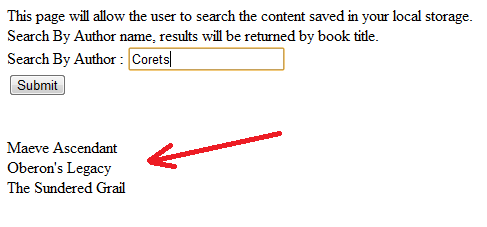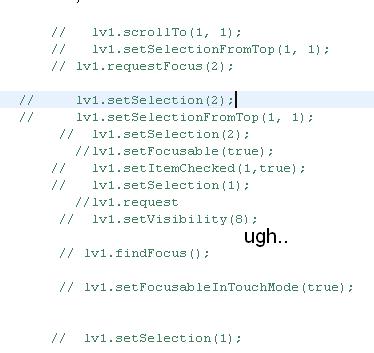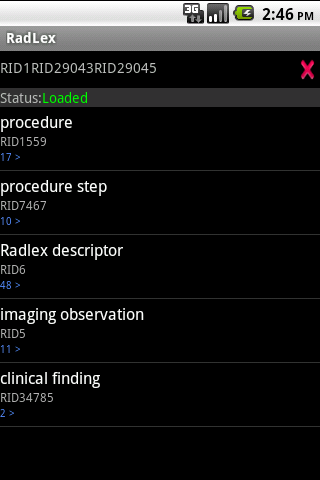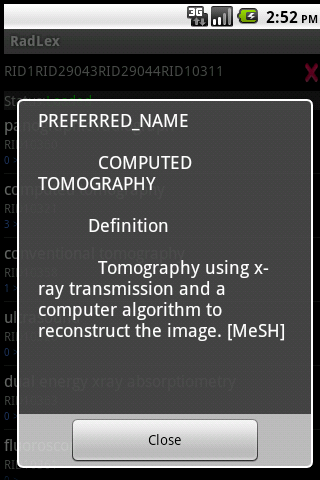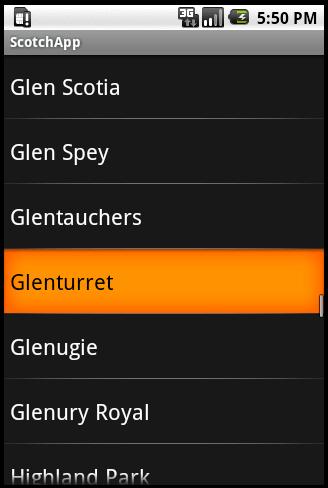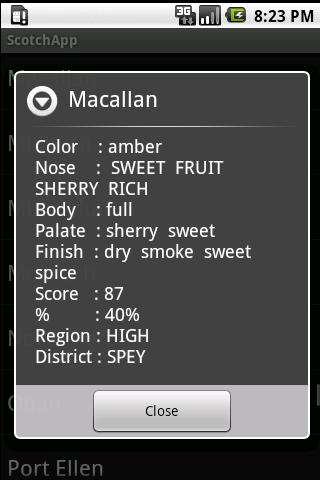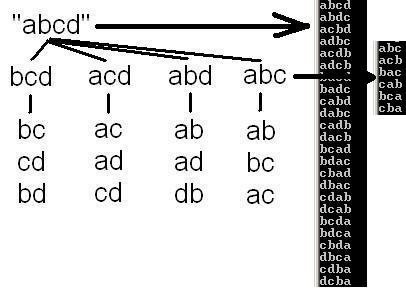This tutorial will give a brief overview of how to modify a Protégé-Frames dictionary using Java.
Download Protege:
protege.stanford.edu/
Reference the API:
protege.stanford.edu/protege/3.4/docs/api/core/
The Following examples will require these imports:
import edu.stanford.smi.protege.model.Cls;
import edu.stanford.smi.protege.model.Instance;
import edu.stanford.smi.protege.model.KnowledgeBase;
import edu.stanford.smi.protege.model.Project;
import edu.stanford.smi.protege.model.Slot; |
import edu.stanford.smi.protege.model.Cls;
import edu.stanford.smi.protege.model.Instance;
import edu.stanford.smi.protege.model.KnowledgeBase;
import edu.stanford.smi.protege.model.Project;
import edu.stanford.smi.protege.model.Slot;
Assuming you’ve successfully associated the appropriate Protege libraries with your Eclipse, lets get started with some simple HOW-TOs in programmatical Protege ontology manipulation;
For this tutorial I will be using the RadLex Lexicon/Dictionary.
The first thing you will need is the actual project files.
Mine are called : RadLex.pins, RadLex.pont, and RadLex.pprj
These files are created when you save a Lexicon/Dictionary in Frames format using Protege.
Create a pointer to them in your java code. I have mine in in C:\smelo\RadLex.pprj
You only have to point to the *.pprj file.
//Get the project file of the lexicon you want to manipulate
private static final String PROJECT_FILE_Pointer = "C:\\smelo\\RadLex.pprj"; |
//Get the project file of the lexicon you want to manipulate
private static final String PROJECT_FILE_Pointer = "C:\\smelo\\RadLex.pprj";
Next, you will need to get the KnowledgeBase object.
//errors object is required in getting the project
Collection errors = new ArrayList();
//Get Project project
Project project = new Project(PROJECT_FILE_Pointer, errors);
//Get Knowledgebase kb
KnowledgeBase kb = project.getKnowledgeBase(); |
//errors object is required in getting the project
Collection errors = new ArrayList();
//Get Project project
Project project = new Project(PROJECT_FILE_Pointer, errors);
//Get Knowledgebase kb
KnowledgeBase kb = project.getKnowledgeBase();
In Protege Frames, each Term/Concept/Lexicon Entity/Thingy is considered a “class”(Cls). The entire RadLex dictionary is nothing more then a bunch of terms(classes) with attributes(slots), and the relationships amongst them.
So lets iterate through all the classes in the KnowledgeBase.
To do this we need to get a class iterator:
//RadLex Class iterator
Iterator radClsIter = kb.getClses().iterator(); |
//RadLex Class iterator
Iterator radClsIter = kb.getClses().iterator();
Loop through every class
In RadLex, the “name” of every class is its Radlex Id number, or “RID###..”
such as “RID1099” “RID35707” “RID3874” ….
Every RadLex class contains a number of “slots” or attributes that you can populate:
Using the method .getOwnSlots() on a Cls Object will show you a list of all the slots and their names
These are all different attributes(slots) of a single concept(Cls) in RadLex:
Slot(Related_Condition), Slot(Anatomical_Site), Slot(Related_modality), Slot(ACR_ID), Slot(UMLS_Term), Slot(Is_A), Slot(UMLS_ID), Slot(Misspelling of term), Slot(Has_Subtype), Slot(Non-English_name), Slot(Member_Of), Slot(Preferred_name), Slot(Source), Slot(Non-Sanctioned Synonym), Slot(Synonym), Slot(Version_Number), Slot(Term_Status), Slot(SNOMED_ID), Slot(Acronym), Slot(SNOMED_Term), Slot(ACR_Term), Slot(Comment), Slot(Image_URL), Slot(Definition), Slot(:ROLE), Slot(:DOCUMENTATION), Slot(:SLOT-CONSTRAINTS), Slot(:DIRECT-INSTANCES), Slot(:DIRECT-SUPERCLASSES), Slot(:DIRECT-SUBCLASSES), Slot(:DIRECT-TEMPLATE-SLOTS), Slot(:NAME), Slot(:DIRECT-TYPE)
Some slot types are simple strings, while others are more complex Instances.
while( radClsIter.hasNext() )
{
Cls currentClass = radClsIter.next();
} |
while( radClsIter.hasNext() )
{
Cls currentClass = radClsIter.next();
}
So now that we have a brief scattered overview of the RadLex Lexicon/Dictionary,
and we know how to iterate through each Concept/Term/Class within it. Lets do some practical HOW-TOs.
HOW TO get the value of “Preferred_name” slot from a class object(currentClass)?
One way of retrieving of the content of a slot of a class would be by the slot’s name.
So all you have to do is, get another slot iterator this time for the class(term/concept), and compare its name with the one you want.
Then, iterate through the content of the slot and display its value.(You might not have to do this last step; it depends of the type of slot)
In RadLex the Preferred_name slot of a class is populated with an Instance type.
So we have to get the instance of a slot then get the name of the Instance.
String slotName = "Preferred_name";
Iterator slotIter = currentClass.getOwnSlots().iterator();
//Iterate through the slots
while( slotIter.hasNext() )
{
Slot currentSlot = slotIter.next();
//Compare the slot name with your slotName String
if( slotName.equals( currentSlot.getName() ) )
{
Object slotContentObject = null;
//Create another iterator for the content of the slot
Iterator iterSlotContent = currentClass.getOwnSlotValues(currentSlot).iterator();
if( iterSlotContent.hasNext() )
{
slotContentObject = iterSlotContent.next();
//if the content of a slot is of type Instance
if(slotContentObject instanceof Instance)
{
//cast to Instance
Instance instSlotValue = (Instance) slotContentObject;
//use the method getBrowserText() on the Instance to get its String content
System.out.println(instSlotValue.getBrowserText());
}
}
}
} |
String slotName = "Preferred_name";
Iterator slotIter = currentClass.getOwnSlots().iterator();
//Iterate through the slots
while( slotIter.hasNext() )
{
Slot currentSlot = slotIter.next();
//Compare the slot name with your slotName String
if( slotName.equals( currentSlot.getName() ) )
{
Object slotContentObject = null;
//Create another iterator for the content of the slot
Iterator iterSlotContent = currentClass.getOwnSlotValues(currentSlot).iterator();
if( iterSlotContent.hasNext() )
{
slotContentObject = iterSlotContent.next();
//if the content of a slot is of type Instance
if(slotContentObject instanceof Instance)
{
//cast to Instance
Instance instSlotValue = (Instance) slotContentObject;
//use the method getBrowserText() on the Instance to get its String content
System.out.println(instSlotValue.getBrowserText());
}
}
}
}
HOW TO change the Definition slot of a Class/Concept/Term by specific “name” (RID) and save to project file?
Say we want to change the content of the “Definition” slot in Cls “RID35712”:
String slotName = "Definition";
//get the Cls object of the Term/Concept/Class
Cls myConcept = kb.getCls( "RID35712" );
Iterator myConceptClsIter = myConcept.getOwnSlots().iterator();
while( myConceptClsIter.hasNext() )
{
Slot currentSlot = myConceptClsIter.next();
if(slotName.equals(currentSlot.getName()) )
{
//set new Definition
myConcept.setOwnSlotValue(currentSlot, "This is my new Definition for Term RID35712");
}
}
//save changes
project.save(errors); |
String slotName = "Definition";
//get the Cls object of the Term/Concept/Class
Cls myConcept = kb.getCls( "RID35712" );
Iterator myConceptClsIter = myConcept.getOwnSlots().iterator();
while( myConceptClsIter.hasNext() )
{
Slot currentSlot = myConceptClsIter.next();
if(slotName.equals(currentSlot.getName()) )
{
//set new Definition
myConcept.setOwnSlotValue(currentSlot, "This is my new Definition for Term RID35712");
}
}
//save changes
project.save(errors);
HOW TO display ALL synonyms of the entire project?
What if we want to list the names of ALL synonyms throughout the entire dictionary
Iterator radClsIter = kb.getClses().iterator();
while( radClsIter.hasNext() ){
Cls currentClass = radClsIter.next();
String prefName = findPreferredName(currentClass);
String slotName = "Synonym";
Iterator slotIter = currentClass.getOwnSlots().iterator();
while( slotIter.hasNext() )
{
Slot currentSlot = slotIter.next();
if(slotName.equals(currentSlot.getName()) )
{
Object slotContentObject = null;
Iterator iterSlotContent = currentClass.getOwnSlotValues(currentSlot).iterator();
if( iterSlotContent.hasNext() )
{
slotContentObject = iterSlotContent.next();
if(slotContentObject instanceof Instance)
{
Instance instSlotValue = (Instance) slotContentObject;
System.out.println(instSlotValue.getBrowserText());
}
}
}
}
} |
Iterator radClsIter = kb.getClses().iterator();
while( radClsIter.hasNext() ){
Cls currentClass = radClsIter.next();
String prefName = findPreferredName(currentClass);
String slotName = "Synonym";
Iterator slotIter = currentClass.getOwnSlots().iterator();
while( slotIter.hasNext() )
{
Slot currentSlot = slotIter.next();
if(slotName.equals(currentSlot.getName()) )
{
Object slotContentObject = null;
Iterator iterSlotContent = currentClass.getOwnSlotValues(currentSlot).iterator();
if( iterSlotContent.hasNext() )
{
slotContentObject = iterSlotContent.next();
if(slotContentObject instanceof Instance)
{
Instance instSlotValue = (Instance) slotContentObject;
System.out.println(instSlotValue.getBrowserText());
}
}
}
}
}
HOW TO create a new Class/Concept/Term and Add it as a child of RID35712?
We will be assigning the “name” as new unique “RID12345” and adding it as child of the term “RID35712”
Collection myCol = kb.getClsNameMatches("RID35712",1);
kb.createCls("RID12345", myCol); |
Collection myCol = kb.getClsNameMatches("RID35712",1);
kb.createCls("RID12345", myCol);
That covers a few basics, if you would like an example of something I havent covered, feel free to leave a comment.
GL & HF :D


